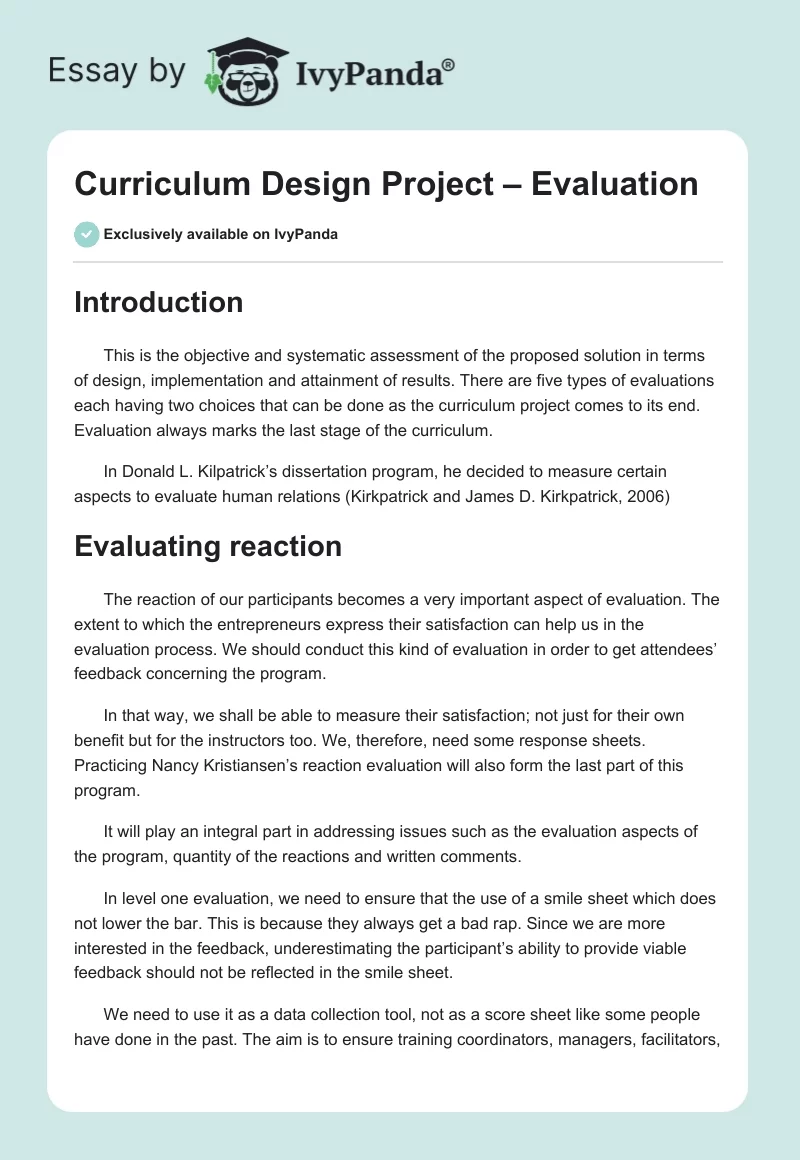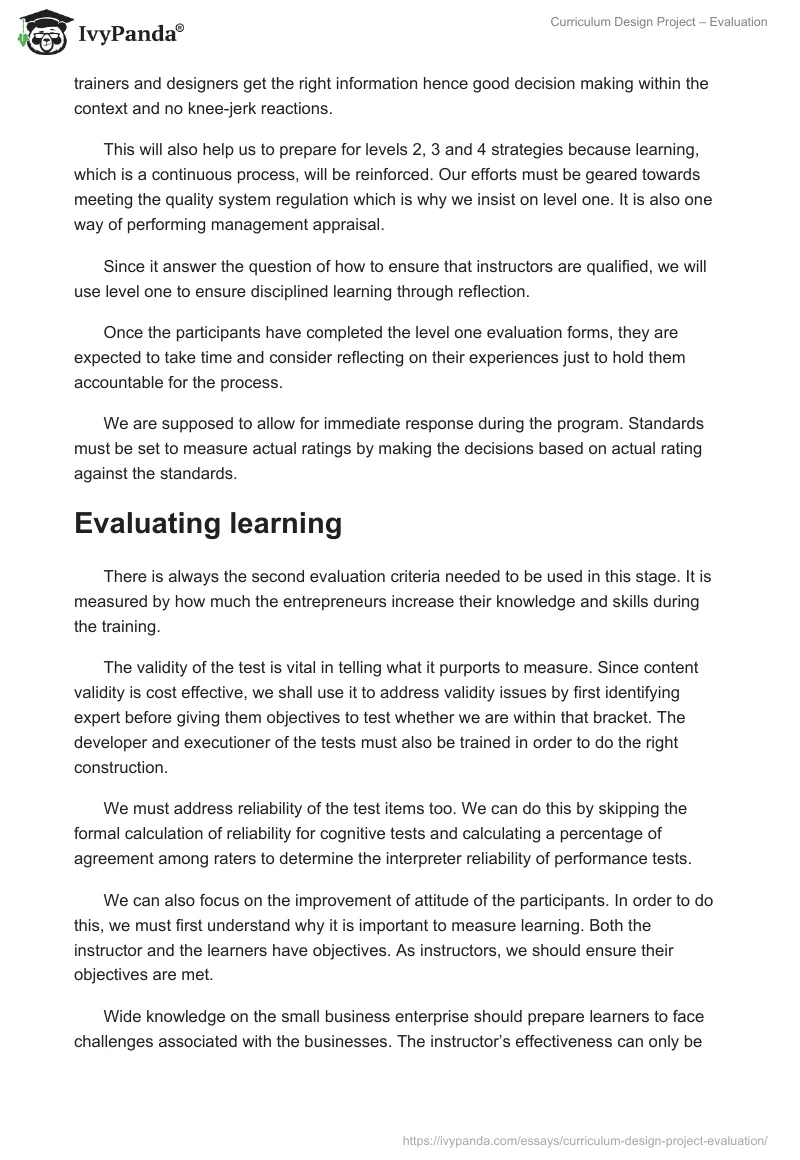Introduction
This is the objective and systematic assessment of the proposed solution in terms of design, implementation and attainment of results. There are five types of evaluations each having two choices that can be done as the curriculum project comes to its end. Evaluation always marks the last stage of the curriculum.
In Donald L. Kilpatrick’s dissertation program, he decided to measure certain aspects to evaluate human relations (Kirkpatrick and James D. Kirkpatrick, 2006)
Evaluating reaction
The reaction of our participants becomes a very important aspect of evaluation. The extent to which the entrepreneurs express their satisfaction can help us in the evaluation process. We should conduct this kind of evaluation in order to get attendees’ feedback concerning the program.
In that way, we shall be able to measure their satisfaction; not just for their own benefit but for the instructors too. We, therefore, need some response sheets. Practicing Nancy Kristiansen’s reaction evaluation will also form the last part of this program.
It will play an integral part in addressing issues such as the evaluation aspects of the program, quantity of the reactions and written comments.
In level one evaluation, we need to ensure that the use of a smile sheet which does not lower the bar. This is because they always get a bad rap. Since we are more interested in the feedback, underestimating the participant’s ability to provide viable feedback should not be reflected in the smile sheet.
We need to use it as a data collection tool, not as a score sheet like some people have done in the past. The aim is to ensure training coordinators, managers, facilitators, trainers and designers get the right information hence good decision making within the context and no knee-jerk reactions.
This will also help us to prepare for levels 2, 3 and 4 strategies because learning, which is a continuous process, will be reinforced. Our efforts must be geared towards meeting the quality system regulation which is why we insist on level one. It is also one way of performing management appraisal.
Since it answer the question of how to ensure that instructors are qualified, we will use level one to ensure disciplined learning through reflection.
Once the participants have completed the level one evaluation forms, they are expected to take time and consider reflecting on their experiences just to hold them accountable for the process.
We are supposed to allow for immediate response during the program. Standards must be set to measure actual ratings by making the decisions based on actual rating against the standards.
Evaluating learning
There is always the second evaluation criteria needed to be used in this stage. It is measured by how much the entrepreneurs increase their knowledge and skills during the training.
The validity of the test is vital in telling what it purports to measure. Since content validity is cost effective, we shall use it to address validity issues by first identifying expert before giving them objectives to test whether we are within that bracket. The developer and executioner of the tests must also be trained in order to do the right construction.
We must address reliability of the test items too. We can do this by skipping the formal calculation of reliability for cognitive tests and calculating a percentage of agreement among raters to determine the interpreter reliability of performance tests.
We can also focus on the improvement of attitude of the participants. In order to do this, we must first understand why it is important to measure learning. Both the instructor and the learners have objectives. As instructors, we should ensure their objectives are met.
Wide knowledge on the small business enterprise should prepare learners to face challenges associated with the businesses. The instructor’s effectiveness can only be proven when there is evidence of learning from the entrepreneurs. Some guidelines will help us in evaluating our entrepreneurial specialty.
These are amongst others measuring knowledge, skills and attitude, before and after the program. This, therefore, means that evaluation will be done even in the previous stages of our program.
We will ensure the participants are provided with a pen and paper through which we will test their knowledge. Performance test are also important and responses must be given during this assessment (Robert, 2003).
Evaluating behavior
Our curriculum will also be evaluated in terms or the behavior of the participants especially in the way they apply what they learn once they are done with the curriculum.
A before-and-after basis assessment will be done in this evaluation but in some cases we may allow the after-basis on its own once we have done our findings. Since this evaluation focuses more on the assessment of the result, we shall give the trainees more time to improve their behavior.
We can use the success case evaluation method during this process (Brinkerhoff, 2006). This should be done every three months. The measurement of change will involve inquiring from the participants’ customers and employees in their small businesses. Their peers may also help with relevant information.
Evaluating impact or result
Finally, the results obtained in selecting contents of dissatisfaction will matter a lot. These are the assessments done after the proposed training is over. Therefore, the impact must be clearly seen. The entrepreneurs should report increase in sales or production.
Their interaction with customers must also improve and they must show a high level of satisfaction. We shall use a close loop process to reflect the participants’ reaction to the training or learning experience.
A well planned and design level 1 evaluation can help us to achieve this. For this reason, we will have to use the same strategies of evaluating reaction. The Deming circle of 150s (Deming, 2000) can be adopted in this assessment.
This may assist to integrate a continuous improvement; also called the total quality management model. As a result, we will know whether the entrepreneurs have a chance develop effective strategies that will help them change their perspectives of doing a business alone.
Since this is an evaluation stage, it also helps to evaluate the participants’ readiness to face risks involved in entrepreneurship as we monitor the continuous improvement in the training cycle.
Conclusion
This curriculum program is essential because it encompasses the relevant issues like how to identify a good business and we develop the abilities to do them. All these are mentioned in the first stage of our project.
In the second stage where we discuss our implementation designs, the three stages of preparation will enable us have a good base for the program. This is important in the psychological and physical preparation for the program.
The final stage characterized by various levels of evaluation, ensures the program has achieved its expected results so that our goals are met. I believe strongly this curriculum will have a positive impact.
References
Brinkerhoff, Robert O. (2006). Telling training’s story. San Francisco: Berrett- Koehler.
Deming, W. Edward. (2000). out of the crisis. London: MIT press. Brinkerhoff, Robert O. (2003). The success case method. San Francisco: Berrett-Koehler.
Kirkpatrick, Donald L, and James D. Kirkpatrick. (2006). Evaluating training programs: The four levels. 3d ed. San Francisco: Berrett-Koehler


